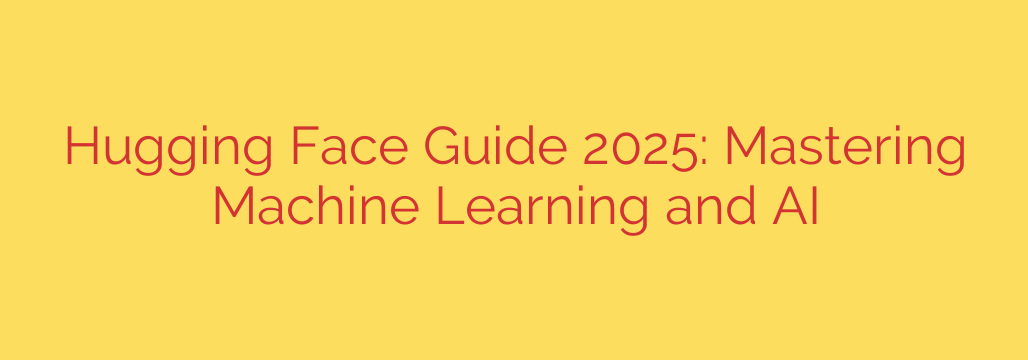
Hugging Face Explained: The Ultimate Guide to the AI and Machine Learning Hub
The world of Artificial Intelligence can feel complex and inaccessible, reserved for tech giants and elite research labs. However, one platform has radically changed the landscape, becoming the central meeting point for developers, researchers, and enthusiasts alike. That platform is Hugging Face.
Often described as the GitHub for machine learning, Hugging Face has evolved into a comprehensive ecosystem that is dramatically accelerating AI development and making it accessible to everyone. Whether you’re a seasoned data scientist or just starting your AI journey, understanding Hugging Face is essential.
What Exactly is Hugging Face?
At its core, Hugging Face is a community-driven platform and company dedicated to advancing AI through open-source collaboration. It’s not just one tool, but a collection of powerful resources that work together to simplify the entire machine learning workflow, from finding a model to deploying a full-fledged application.
The central idea is to prevent the constant reinvention of the wheel. Instead of every team spending months and millions of dollars training a large language model from scratch, they can use a pre-trained model from the Hugging Face Hub and fine-tune it for their specific task in a fraction of the time.
The Core Components of the Hugging Face Ecosystem
To truly grasp its power, you need to understand the key pillars that make up the Hugging Face ecosystem.
- The Hugging Face Hub: This is the heart of the platform. The Hub is a massive, centralized repository where the community can share and discover tens of thousands of pre-trained models, datasets, and interactive demos (called Spaces). You can find a model for almost any task, including text summarization, image generation, language translation, and audio classification.
- The Transformers Library: This is arguably the most famous part of Hugging Face. The
transformerslibrary is a Python-based, open-source tool that provides a standardized, incredibly simple interface for accessing the models on the Hub. With just a few lines of code, you can download and use a state-of-the-art model like BERT, GPT-2, or T5. - The Datasets Library: Machine learning models are useless without data. The
datasetslibrary provides efficient access to thousands of datasets, streamlining the often-tedious process of downloading, processing, and preparing data for training. It features smart caching and memory-mapping to handle even massive, multi-gigabyte datasets with ease. - The Tokenizers Library: Before a model can process text, that text must be converted into numbers—a process called tokenization. The
tokenizerslibrary offers a fast and versatile implementation of the most common tokenizers used by modern NLP models, serving as the crucial bridge between human language and machine understanding. - Hugging Face Spaces: Spaces allow you to build, host, and share live demos of your machine learning applications directly on the platform. It’s a fantastic way to showcase your work, create an interactive portfolio, or collaborate with others on a project without worrying about complex infrastructure.
Getting Started: A Practical Example with the pipeline
The easiest way to see the magic of Hugging Face is through the pipeline function in the transformers library. It abstracts away all the complex steps—like tokenization, model inference, and post-processing—into a single, simple command.
For example, here’s how you can perform sentiment analysis on a sentence with just three lines of Python code:
from transformers import pipeline
# 1. Create a sentiment analysis pipeline
classifier = pipeline("sentiment-analysis")
# 2. Use the pipeline to analyze your text
result = classifier("Hugging Face makes using state-of-the-art AI incredibly simple.")
# 3. Print the result
print(result)
# Output: [{'label': 'POSITIVE', 'score': 0.9998}]
In the background, Hugging Face automatically downloaded a pre-trained sentiment analysis model and its tokenizer, processed your input, and returned a clean, easy-to-understand result. This same principle applies to dozens of other tasks, from translation to object detection.
A Critical Look at Security: Staying Safe on the Hub
The open-source nature of the Hugging Face Hub is its greatest strength, but it also introduces potential security risks. Since anyone can upload a model, you must be cautious about what you download and run.
Here are some essential security tips to follow:
- Trust Reputable Sources: Prioritize models uploaded by official organizations (like Google, Meta, or Microsoft) or by well-known, active members of the Hugging Face community. Check the creator’s profile and the model’s download count and likes.
- Scan for Malicious Code: Model files, particularly in the older
pickleformat, can potentially contain arbitrary code. Before loading a model from an unknown source, consider using a code scanner or running it in a sandboxed environment. - Prefer SafeTensors: Hugging Face has been promoting a new, safer file format called
safetensors. Unlikepickle, this format only contains the model’s weights (the data) and not executable code, making it immune to code injection vulnerabilities. When possible, always choose models available in the.safetensorsformat.
Why Hugging Face is a Game-Changer
Hugging Face has fundamentally reshaped the AI landscape for several key reasons:
- Democratization of AI: It lowers the barrier to entry, allowing smaller companies, startups, and individual developers to leverage powerful AI models that were once exclusive to tech giants.
- Rapid Prototyping and Development: The ability to quickly experiment with different models from the Hub drastically reduces development time.
- Collaboration and Reproducibility: By centralizing models and datasets, the Hub fosters a more collaborative and transparent research environment.
In summary, Hugging Face is more than just a library; it’s the central engine driving the collaborative, open-source future of artificial intelligence. By providing the tools, infrastructure, and community, it empowers anyone to build with the most advanced AI technology in the world.
Source: https://collabnix.com/hugging-face-complete-guide-2025-the-ultimate-tutorial-for-machine-learning-and-ai-development/








